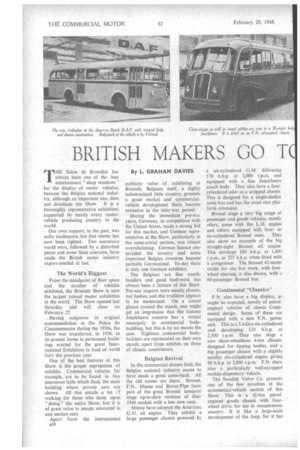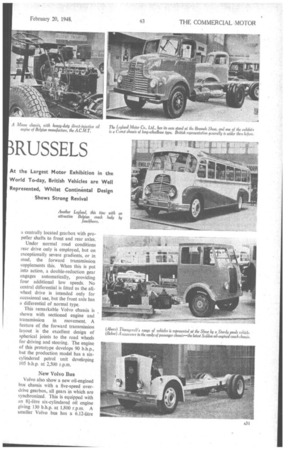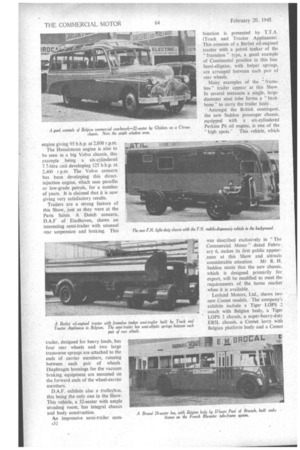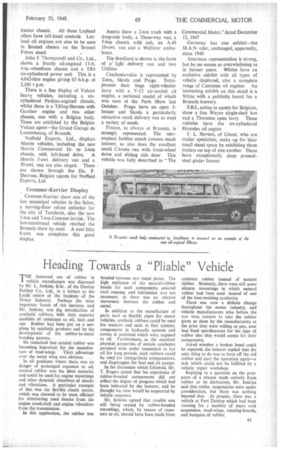BRITISH MAKERS GO T RUSSELS
Page 32

Page 33

Page 34

Page 35

If you've noticed an error in this article please click here to report it so we can fix it.
By L. GRAHAM DAVIES THE Salon de Bruxelles has always been one of the best international 'shop windows" for the display of motor vehicles, because the Belgian national industry, although an important one, does not dominate the Show. It is a thoroughly representative exhibition, supported by nearly every motorvehicle producing country in the world.
Our own support, in the past, was sadly inadequate, but that matter has now been righted. Two successive world wars, followed by a disturbed peace and some State coercion, have made • the British motor industry export-minded at last.
The World's Biggest From the standpoint of floor space and the number of vehicles exhibited, the Brussels Show is now the largest annual motor exhibitlon in the world. The Show opened last Saturday and will close on February 25.
Having outgrown its original accommodation in the Palais du Cinquantenaire during the 1930s, the Show was transferred, in 1936, to its present home in permanent buildings erected for the great International Exhibition (a kind of world fair) the previous year
One of the best features of this Show is the proper segregation of exhibits, Commercial vehicles, for example, are to be found in two enormous halls which flank the main building where private cars are shown. All this entails a lot c f walking for those who insist upon " doing " the entire Show, but it is of great value to people interested in one section only
Apart from the international £30 publicity value of exhibiting at Brussels, Belgium itself, a highly industrialized little country, presents a good market and commercialvehicle development there became extensive in the inter-war period.
During the immediate pre-war years, Germany, in competition with the United States, made a•strong bid for this market, and German representation at the Show, particularly in the commercial section, was almost overwhelming. German finance also invaded the country and some important Belgian concerns becam6 partially Germanized. To-day there is only one German exhibitor.
The Belgians are fine coachbuilders and good bodywork has always been a feature of this Show. Pre-war imports were mostly chassis. not bodies, and this tradition appears to be maintained. On a casual glance around the stands, one might get an impression that the famous Jonckheere concern has a virtual monopoly in commercial bodybuilding, but this is by no means the case. Eighteen commercial bodybuilders are represented on their own stands, apart from exhibits on those of chassis constructors.
Belgian Revival
In the commercial chassis field, the Belgian national industry seems to, have made a good come-back. All the old names are there. Brossel, F.N., Miesse and Bovey-Pipe (now part of the. great Brossel concern) stage up-to-date versions of their 1940 models with a few new ones Miesse have adopted the American G.M. oil engine. They exhibit a large passenger chassis powered by a six-cylindered G.M. delivering 170 b.h.p. at 2,000 r.p.m. and equipped with a fine Jonckheere coach body. They also have a fourcylindered oiler as a stripped chassis This is designed for a single-decker town bus and has the usual rear platform extension.
Brossel stage a very big range of passenger and goods vehicles, mostly oilers, some with the L.M. engine and others equipped with fouror six-cylindered Brossel units. They also show an example of the big straight-eight Brossel oil engine This develops 180 b.h.p. at 1,800 r.p.m., or 225 b.h.p. when fitted with a compressor The Brossel 42-seater trailer for city bus work, with fourwheel steering, is also shown, with a 60-passenger Brossel bus.
Continental "Classics" F.N also have a big display, as might be expected, mostly of petrolengined vehicles of classic Continental design. Some of these are equipped with a new F.N.. power unit. This is a 5.4-litre six-cylindered unit developing 110 b.h.p. at 2,500 r.p.m. They also stage a new short-wheelbase 4-ton chassis, designed for tipping bodies, and a big passenger chassis with a slightly smaller six-cylindered engine giving 80 b.h.p. at 2,800 r.p.m. F.N. show also a particularly well-equipped mobile-dispensary vehicle.
The Swedish Volvo Co. presents one of the few novelties in the commercial-vehicle section of this• Show This is a 41-ton petrolengined goods chassis with fourwheel drive, for use in mountainous 'country_ It is like a large-scale development of the Jeep, for it has a centrally located gearbox with propeller shafts to front and rear axles.
Under normal road conditions rear drive only is employed, but on exceptionally severe gradients, or in mud, the forward transmission supplements this. When this is put into action, a double-reduction gear engages automatically, providing four additional low speeds.. No central differential is fitted as the allwheel drive is intended only for occasional use, but the front axle has a differential of normal type.
This remarkable Volvo chassis is shown with sectioned engine and transmission in movement. A feature of the forward transmission layout is the excellent design of spherical joints to the road wheels for driving and steering. The engine of this prototype develops 90 b.h.p., but the production model has a sixcylindered petrol unit developing 105 b,h.p. at 2,500 r.p.m.
New Volvo Bus Volvo also show a new oil-engined bus chassis with a five-speed overdrive gearbox, all gears in which are synchronized. This is equipped with an 8i-litre six-cylindered oil engine giving 130 b.h.p. at 1,800 r.p.m. A smaller Volvo bus has a 6.12-litre
engine giving 95 b.h.p. at 2,000 r.p.m.
The Hesselmann engine is also to be seen in a big Volvo chassis, this example being a six-cylindered 7.7-litre unit developing 125 b.h.p. at 2,400 r.p.m. The Volvo concern has been developing this directinjection engine, which uses paraffin or low-grade petrols, for a number of years. It is claimed that it is now giving very satisfactory results.
Trailers are a strong feature of this Show, just as they were at the Paris Salon. A Dutch concern, D.A.F. of Eindhoven, shows an interesting semi-trailer with unusual rear suspension and braking. This
trailer, designed for heavy loads, has four rear wheels and two large transverse springs are attached to the ends of carrier members, running between each pair of wheels Diaphragm housings for the vacuum braking equipment are mounted on the forward ends of the wheel-carrier members.
D.A.F. exhibits also a trolleybus, this being the only one in the Show. This vehicle, a 32-seater with ample standing room, has integral chassis and body construction.
An impressive semi-trailer cornA32 bination is presented by T.T.A. (Truck and Tractor Appliances). This consists of a Berliet oil-engined tractor with a petrol tanker of the " frameless" type, a good example of Continental practice in this line. Semi-eliiptics, with helper springs, are arranged between each pair of rear wheels.
Many examples of the " frameless" trailer appear at this Show. In several instances a single, largediameter steel tube forms a "backbone" to carry the trailer body.
Amongst the British contingent, the new Seddon passenger chassis, equipped with a six-cylindered Perkins P6 oil engine, is one of the high spots." This vehicle, which was described exclusively in "[he Commercial Motor " dated February 6, makes its first public appear,ance at this Show and attracts
considerable attention. Mr R. H. Seddon states that the new chassis. which is designed primarily for export, will be modified to meet the requirements of the home market when it is available.
Leyland Motors, Ltd., shows two new Comet models. The company's exhibits include a Tiger LOPS 2 coach with Belgian body, a Tiger LOPS 3 chassis, a super-heavy-duty
tractor chassis. All these Leyland
oilers have left-hand controls. Leyland oil engines are also to be seen in Brossel chassis on the Brossel Freres stand.
John J. Thornycroft and Co., Ltd., shows a Sturdy oil-engined 13-ft. 4-in.-wheelbase chassis and a TR6 six-cylindered power unit This is a 4.042-litre engine giving 65 b.h.p. at 2,100 r p.m.
There is a fine display of Vulcan heavy vehicles, including a sixcylindered Perkins-engined chassis, whilst there is a Tilling-Stevens with Gardner engine and two other chassis, one with a Belgian body. These are exhibited by the Belgian Vulcan agent—the Grand Garage de Luxembourg, of Brussels.
Nuffield Exports, Ltd., displays Morris vehicles, including the new Morris Commercial Iito 2-ton chassis, with left-hand drive. A Morris 5-cwt. delivery van and a 10-cwt. van are also staged. These are shown through the Ets. P. Decrose, Belgian agents for Nuffield Exports, Ltd.
Commer-Karrier Display
Commer-Karrier show one of the few municipal vehicles in the Salon, a moving-floor refuse collector for the city of Turnhout, also the new 5-ton arid 7-ton Commer lorries. The last-mentioned vehicle reached the Brussels show by road. A neat little 8-cwt. van completes this good display. Austin show a 2-ton truck with a drop-side body, a Three-way van; a 5-ton chassis with cab, an A.40 10-cwt. van and a Welfarer ambulance. .
The Bradford is shown in the form of e light delivery van and two Utilities Czechoslovakia is represented by Tatra, Skoda and Prep. Tatrapresent their huge eight-wheeler lorry with a V-12 air-cooled oil engine, a sectional model of which was seen at the Paris Show last October. Praga have an open 3tonner and Skoda a. particularly attractive small delivery van to meet a variety of needs.
France, as always at Brussels, is strongly represented. The rearengined Isobloe coach amuses much interest, as also does the excellent small Citroen van with front-wheel drive and sliding side door This vehicle was fully described in "The
Commercial Motor," dated December 12, 1947 Germany has one exhibit—the M.A.N oiler, unchanged, apparently, since 1940.
American representation is strong, but by no means so overwhelming as in former years. Whites have an exclusive exhibit with all types of vehicle displayed, also a complete range of Cummins oil engines An interesting exhibit on this stand is a White with a publicity board for a Brussels brewery.
S.B.I., acting as agents for Belgium, show a fine Wayne single-deck bus and a Thornton open lorry. These vehicles have the six-cylindered Hercules oil engine. •
F. L. Steveni, of Ghent, who are trailer speCialists, make up for their small stand space by exhibiting three trailers on top of one another. These have exceptionally deep pressedsteel girder frames




















































































